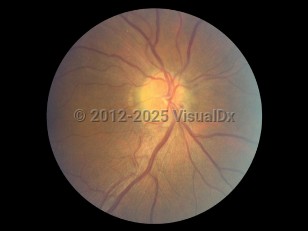Anterior ischemic optic neuropathy - External and Internal Eye
Alerts and Notices
Important News & Links
Synopsis

There are generally 2 forms of AION: arteritic and nonarteritic. The nonarteritic type (NAION) is associated with optic nerve anatomy and changes in blood pressure. The arteritic type (AAION) is inflammatory in nature and usually related to giant cell arteritis (GCA).
GCA is a systemic vasculitis that mainly involves medium- and large-sized arteries. GCA is rarely found in people younger than 55, and the mean age for disease presentation is 76. Patients with GCA may present with systemic symptoms, including scalp tenderness, jaw claudication, headache, anorexia, weight loss, neck pain, myalgia, fatigue, and anemia. Other rare causes of AAION include other types of vasculitis such as polyarteritis nodosa, systemic lupus erythematosus, and herpes zoster.
NAION is much more common and generally occurs in patients aged between 55 and 65. Up to 95% of patients with NAION are white. Risk factors include hypertension, diabetes mellitus, hypercholesterolemia, small cup-to-disc ratio, coagulopathies, history of profound blood loss with hypotension, history of cataract surgery, and optic disc drusen.
Patients with NAION usually experience a painless loss of vision, while patients with AAION typically have severe headache associated with vision loss. About 10% of patients with NAION do suffer from either eye pain or headache, though.
Vision loss is usually much more profound in AAION compared with NAION. With AAION, vision often ranges between hand motion and no light perception, while in NAION, vision is usually better than 20/200. The degree of color vision loss is usually proportional to the amount of vision loss. AAION tends to be bilateral (unless spared by early treatment intervention), while NAION usually presents unilaterally, with the second eye becoming involved in 15% of patients within 5 years of diagnosis.
Codes
H47.019 – Ischemic optic neuropathy, unspecified eye
SNOMEDCT:
404659001 – Anterior Ischemic Optic Neuropathy
Look For
Subscription Required
Diagnostic Pearls
Subscription Required
Differential Diagnosis & Pitfalls

Subscription Required
Best Tests
Subscription Required
Management Pearls
Subscription Required
Therapy
Subscription Required
Drug Reaction Data
Subscription Required
References
Subscription Required

